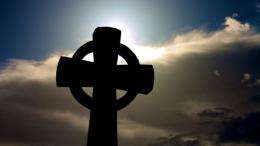Celtic cross. Credit: Andrea Raia from Flickr (Creative Comons: Att-NC-SA)
With St Patrick's Day upon us, a new study asks whether the saint fled his native Britain to escape a career as a Roman tax collector, only to arrive in Ireland and sell slaves.
The classic account of St. Patrick’s life tells us that he was abducted from Western Britain in his teens and forced into slavery in Ireland for six years before escaping, during which time his faith developed.
A new study looking at Patrick’s own writings in their historical context argues that the saint may have in fact fled to Ireland deliberately to avoid becoming a ‘Decurion’ – a Roman official responsible for tax collection.
The onerous duties of Decurions, and especially the requirement to make up for any shortfall in the tax revenues from their own pockets, was a strong incentive to abscond. Historians have long been aware of the possibility that Patrick’s own father, Calpornius, exploited a bail-out clause in Roman law that allowed him to leave his post as a Decurion by joining the clergy.
What seems to have escaped notice, however, is that the position of Decurion was de facto hereditary and, in addition, Decurions who joined the clergy were obliged by Roman law to install their sons in their place. However, by the time that Patrick was due to inherit his father’s office, the usual hardships of the Decurionate were exacerbated by the political and economic decline that Britain was experiencing.
“In the troubled era in which Patrick lived, which saw the demise and eventual collapse of Roman occupation in Britain in 410, discharging the obligations of a Decurion, especially tax-collecting, would not only have been difficult but also very risky,” says Dr Roy Flechner, of the Department of Anglo-Saxon, Norse and Celtic.
According to Flechner, once Patrick was faced with the obligation to become a Decurion following the void left by his father, he preferred to emigrate overseas. Ireland would have been a natural choice, given its proximity and links with western Britain.
Patrick’s writings reveal that his contemporaries accused him of going to Ireland for financial gain. By his own account, he was a wealthy man when he returned to Ireland after his alleged escape from captivity. Although he never says what his wealth consisted of, it must have been movable wealth of a kind that he could transport across the Irish sea to Ireland.
Ireland did not have a monetary economy at this early stage, so exchanging his family land in Britain for money would have been pointless. Slaves, however, were a highly valued commodity and Patrick mentions that his family owned slaves, which was common for aristocratic families in Britain at this time.
Slaves were also relatively easy to transport, and in the historical context it makes sense that Patrick would have converted his family wealth to slaves or taken the family slaves with him. So was St Patrick, the freed Christian slave of legend, actually a slave owner and trader?
“It may seem strange that a Christian cleric of Patrick’s stature would own slaves, but in late antiquity and the early middle ages the church was a major slave owner – we have early medieval Irish legal texts that regulate the ownership of slaves by the church,” says Flechner.
“The only objections to slavery known in this period and the early middle ages were cases in which Christian slaves were owned by non-Christian masters. Patrick is known to have attempted to free enslaved captives, but
these were Christians whom Patrick had converted himself, and who were sold to Pictish masters.”
“The traditional story that Patrick was kidnapped from Britain, forced to work as a slave, but managed to escape and reclaim his status, is likely to be fiction: the only way out of slavery in this period was to be released by manumission or redeemed, and Patrick never says he was redeemed. The traditional legend was instigated by Patrick himself in the texts he wrote, because this is how he wanted to be remembered.”
Adds Flechner: “Escaped slaves had no legal status and could be killed or recaptured by anyone. The probability that Patrick managed to cross from his alleged place of captivity in western Ireland back to Britain undetected, at a time when transportation was extremely complicated, is highly unlikely. It is interesting that early medieval commentators were uneasy with the account of the escape, and by the seventh century a new legend emerged in which Patrick is said to have attempted to redeem himself. Other commentators draw attention to the similarities between Patrick’s story and Exodus 21:2, which stipulated that slaves must be freed
after six years.”
“None of this is to say that Patrick was not a bishop or that he did not engage in missionary activity, but his primary motives for moving to Ireland were most likely to escape the poisoned chalice of his inherited position in Roman Britain.”
More information: This article was published in Tome: Studies in Medieval History and Law in Honor of Thomas Charles-Edwards, ed. F. Edmonds and P. Russell (Woodbridge: Boydell, 2011).
Provided by University of Cambridge



















